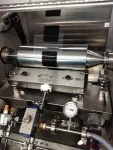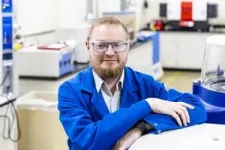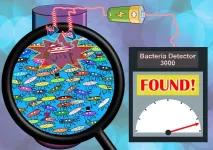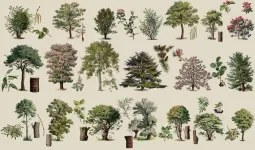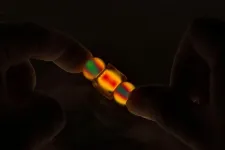(Press-News.org) The Department of Energy’s Oak Ridge National Laboratory is providing national leadership in a new collaboration among five national laboratories to accelerate U.S. production of clean hydrogen fuel cells and electrolyzers.
Hydrogen fuel cells provide power to electric vehicles and buildings using an electrochemical reaction that converts hydrogen and oxygen into heat, water and electricity. The Roll-to-Roll, or R2R, Consortium aims to scale up, speed up and reduce the cost of producing key components of fuel cells and electrolyzers where water molecules are split to make hydrogen. Improving manufacturing technologies for green hydrogen will help bring the U.S. closer to achieving its carbon reduction goals to slow climate change.
“The consortium’s goal is to accelerate commercialization of these fuel cells and electrolyzers through comprehensive understanding of full-scale materials development, electrode fabrication, advanced computing and quality control,” said ORNL scientist Alexey Serov.
Serov and his colleague Yuepeng Zhang at Argonne National Laboratory are deputy directors of the R2R Consortium, which is led by Scott Mauger at the National Renewable Energy Laboratory, or NREL. Lawrence Berkeley National Laboratory and Sandia National Laboratories are also partners in the consortium, funded by DOE’s Office of Energy Efficiency and Renewable Energy Hydrogen and Fuel Cell Technologies Office, or HFTO, through two provisions in the Bipartisan Infrastructure Law: the Clean Hydrogen Electrolysis Program and the Clean Hydrogen Manufacturing and Recycling Program.
Both electrolyzers and fuel cells have parts similar to a battery: Positively and negatively charged electrodes on opposite poles draw ions through an electrolyte. A catalyst at the surface of the electrodes accelerates an electrochemical reaction, which separates or combines hydrogen and oxygen. To manufacture these devices, an active material is coated onto an underlayer being continuously moved by rollers – in other words, a “roll-to-roll” production process.
ORNL’s role in the R2R Consortium will focus on scaling up fuel cell and electrolyzer catalysts, which speed up reactions. Scientists at ORNL and Argonne National Laboratory are already collaborating on crucial aspects of this research. The ORNL team will be working with researchers at NREL on scalable methods of manufacturing electrodes for fuel cells and electrolyzers. Additionally, ORNL will lead a consortium effort on using computer modelling to understand fluid, heat and other flows in advanced chemical reactors for scaling up production of platinum and iridium electrocatalysts.
“ORNL’s team brings its unique expertise to co-lead an effort on materials scale-up though state-of-the art roll-to-roll coating capabilities, world-class imaging and microscopy, and advanced modelling and manufacturing processes redesign,” Serov said.
The goal is to rapidly develop and demonstrate new, cleaner and more affordable manufacturing processes to boost industry adoption of clean hydrogen technologies. Roll-to-roll manufacturing can reduce costs by increasing process efficiency and reducing material waste, but research will address challenges related to synthesizing materials, mixing, coating, drying and quality-control processes and equipment.
The consortium also plans to collaborate with industry on cooperative research and development agreements, with more details to be announced soon. An industrial advisory board will guide the consortium’s research objectives and increase engagement among manufacturers, materials suppliers and the hydrogen industry.
Home to the country’s largest open-access facility for battery manufacturing research and development, ORNL offers crucial opportunities to scale up laboratory discoveries using roll-to-roll coating, electron microscopes and other specialized tools. ORNL scientists Flavio Dal Forno Chuahy and David Cullen will join Serov to support consortium research.
R2R activities will also complement the work of other HFTO consortia, Hydrogen from Next-generation Electrolyzers of Water, orH2NEW, and Million Mile Fuel Cell Truck, or M2FCT. The R2R Consortium will develop processes and pathways to scale up materials and components developed by H2NEW and M2FCT and will work closely with both consortia to ensure relevant metrics, methods and protocols are used.
Together, these efforts will help advance DOE’s H2@Scale vision and Hydrogen Shot goal of reducing the cost of clean hydrogen to $1 per kilogram by 2031.
UT-Battelle manages ORNL for the Department of Energy’s Office of Science, the single largest supporter of basic research in the physical sciences in the United States. The Office of Science is working to address some of the most pressing challenges of our time. For more information, please visit energy.gov/science.
The Department of Energy’s Oak Ridge National Laboratory is providing national leadership in a new collaboration among five national laboratories to accelerate U.S. production of clean hydrogen fuel cells and electrolyzers.
Hydrogen fuel cells provide power to electric vehicles and buildings using an electrochemical reaction that converts hydrogen and oxygen into heat, water and electricity. The Roll-to-Roll, or R2R, Consortium aims to scale up, speed up and reduce the cost of producing key components of fuel cells and electrolyzers where water molecules are split to make hydrogen. Improving manufacturing technologies for green hydrogen will help bring the U.S. closer to achieving its carbon reduction goals to slow climate change.
“The consortium’s goal is to accelerate commercialization of these fuel cells and electrolyzers through comprehensive understanding of full-scale materials development, electrode fabrication, advanced computing and quality control,” said ORNL scientist Alexey Serov.
Serov and his colleague Yuepeng Zhang at Argonne National Laboratory are deputy directors of the R2R Consortium, which is led by Scott Mauger at the National Renewable Energy Laboratory, or NREL. Lawrence Berkeley National Laboratory and Sandia National Laboratories are also partners in the consortium, funded by DOE’s Office of Energy Efficiency and Renewable Energy Hydrogen and Fuel Cell Technologies Office, or HFTO, through two provisions in the Bipartisan Infrastructure Law: the Clean Hydrogen Electrolysis Program and the Clean Hydrogen Manufacturing and Recycling Program.
Both electrolyzers and fuel cells have parts similar to a battery: Positively and negatively charged electrodes on opposite poles draw ions through an electrolyte. A catalyst at the surface of the electrodes accelerates an electrochemical reaction, which separates or combines hydrogen and oxygen. To manufacture these devices, an active material is coated onto an underlayer being continuously moved by rollers – in other words, a “roll-to-roll” production process.
ORNL’s role in the R2R Consortium will focus on scaling up fuel cell and electrolyzer catalysts, which speed up reactions. Scientists at ORNL and Argonne National Laboratory are already collaborating on crucial aspects of this research. The ORNL team will be working with researchers at NREL on scalable methods of manufacturing electrodes for fuel cells and electrolyzers. Additionally, ORNL will lead a consortium effort on using computer modelling to understand fluid, heat and other flows in advanced chemical reactors for scaling up production of platinum and iridium electrocatalysts.
“ORNL’s team brings its unique expertise to co-lead an effort on materials scale-up though state-of-the art roll-to-roll coating capabilities, world-class imaging and microscopy, and advanced modelling and manufacturing processes redesign,” Serov said.
The goal is to rapidly develop and demonstrate new, cleaner and more affordable manufacturing processes to boost industry adoption of clean hydrogen technologies. Roll-to-roll manufacturing can reduce costs by increasing process efficiency and reducing material waste, but research will address challenges related to synthesizing materials, mixing, coating, drying and quality-control processes and equipment.
The consortium also plans to collaborate with industry on cooperative research and development agreements, with more details to be announced soon. An industrial advisory board will guide the consortium’s research objectives and increase engagement among manufacturers, materials suppliers and the hydrogen industry.
Home to the country’s largest open-access facility for battery manufacturing research and development, ORNL offers crucial opportunities to scale up laboratory discoveries using roll-to-roll coating, electron microscopes and other specialized tools. ORNL scientists Flavio Dal Forno Chuahy and David Cullen will join Serov to support consortium research.
R2R activities will also complement the work of other HFTO consortia, Hydrogen from Next-generation Electrolyzers of Water, orH2NEW, and Million Mile Fuel Cell Truck, or M2FCT. The R2R Consortium will develop processes and pathways to scale up materials and components developed by H2NEW and M2FCT and will work closely with both consortia to ensure relevant metrics, methods and protocols are used.
Together, these efforts will help advance DOE’s H2@Scale vision and Hydrogen Shot goal of reducing the cost of clean hydrogen to $1 per kilogram by 2031.
UT-Battelle manages ORNL for the Department of Energy’s Office of Science, the single largest supporter of basic research in the physical sciences in the United States. The Office of Science is working to address some of the most pressing challenges of our time. For more information, please visit energy.gov/science.
END
ORNL helping Roll-to-Roll Consortium scale up hydrogen technology
2024-03-25
ELSE PRESS RELEASES FROM THIS DATE:
Research news from the Ecological Society of America’s journals
2024-03-25
The Ecological Society of America (ESA) presents a roundup of five research articles recently published across its six esteemed journals. Widely recognized for fostering innovation and advancing ecological knowledge, ESA’s journals consistently feature innovative and impactful studies. This compilation of papers explores invasive possum management in New Zealand, afforestation on global rangelands, population regulation in large herbivores and more, showcasing the Society’s commitment to promoting cutting-edge research that furthers ...
ASU Regents Professor inducted into 2024 class of AIMBE College of Fellows
2024-03-25
The American Institute for Medical and Biological Engineering (AIMBE) has announced the induction of Regents Professor Petra Fromme, director of the Biodesign Center for Applied Structural Discovery at Arizona State University, to its College of Fellows.
Election to the AIMBE College of Fellows is among the highest professional distinctions accorded to medical and biological engineers, an honor reserved only for the top 2% of researchers in these fields.
"We welcome Petra's well-earned induction into ...
Novel electrochemical sensor detects dangerous bacteria
2024-03-25
Each year, bacterial infections claim several million lives worldwide. That is why detecting harmful microorganisms is crucial – not only in the diagnosis of diseases but also, for example, in food production. However, the methods available so far are often time-consuming, require expensive equipment or can only be used by specialists. Moreover, they are often unable to distinguish between active bacteria and their decay products.
By contrast, the newly developed method detects only intact bacteria. It makes use of the fact that ...
Cancer therapies show promise in combating tuberculosis
2024-03-25
EMBARGOED UNTIL MARCH 25, 2024 AT 3:00 PM US EST
What could cancer teach us about tuberculosis? That’s a question Meenal Datta has been chasing since she was a graduate student.
Once the body’s immune system is infected with tuberculosis, it forms granulomas — tight clusters of white blood cells — in an attempt to wall off the infection-causing bacteria in the lungs. But more often than not, granulomas do more harm than good.
Charged with analyzing the similarities between granulomas and tumors, Datta discovered that both are structurally and functionally abnormal. ...
Gotta go? New bladder device lets you know
2024-03-25
Should you run to the bathroom now? Or can you hold it until you get home? A new implant and associated smartphone app may someday remove the guess work from the equation.
Northwestern University researchers have developed a new soft, flexible, battery-free implant that attaches to the bladder wall to sense filling. Then, it wirelessly — and simultaneously — transmits data to a smartphone app, so users can monitor their bladder fullness in real time.
The study will be published next week in the Proceedings of the National Academy of Sciences (PNAS). It ...
Seeing the forest for the trees: Species diversity is directly correlated with productivity in eastern U.S. forests
2024-03-25
When scientists and policymakers make tough calls on which areas to prioritize for conservation, biodiversity is often their top consideration. Environments with more diversity support a greater number of species and provide more ecosystem services, making them the obvious choice.
There’s just one problem. There are several ways to measure diversity, and each reveals a slightly different, and sometimes conflicting, view of how life interacts in a forest or other ecosystem.
In a new study published ...
Pairing crypto mining with green hydrogen offers clean energy boost
2024-03-25
ITHACA, N.Y. – Pairing cryptocurrency mining – notable for its outsize consumption of carbon-based fuel – with green hydrogen could provide the foundation for wider deployment of renewable energy, such as solar and wind power, according to a new Cornell University study.
“Since current cryptocurrency operations now contribute heavily to worldwide carbon emissions, it becomes vital to explore opportunities for harnessing the widespread enthusiasm for cryptocurrency as we move toward a sustainable and a climate-friendly future,” said Fengqi You, professor of energy systems engineering at Cornell.
You and doctoral ...
With a new experimental technique, MIT engineers probe the mechanisms of landslides and earthquakes
2024-03-25
Granular materials, those made up of individual pieces, whether grains of sand or coffee beans or pebbles, are the most abundant form of solid matter on Earth. The way these materials move and react to external forces can determine when landslides or earthquakes happen, as well as more mundane events such as how cereal gets clogged coming out of the box. Yet, analyzing the way these flow events take place and what determines their outcomes has been a real challenge, and most research has been confined to two-dimensional experiments that don’t ...
MinJun Kim inducted into the 2024 Class of the AIMBE College of Fellows
2024-03-25
The American Institute for Medical and Biological Engineering (AIMBE) has announced the induction of MinJun Kim, Robert C. Womack Endowed Chair Professor in Engineering at Southern Methodist University to its College of Fellows.
Election to the AIMBE College of Fellows is among the highest professional distinctions accorded to medical and biological engineers, comprised of the top two percent of engineers in these fields. College membership honors those who have made outstanding contributions to "engineering and medicine research, practice, or education” and to “the pioneering of new and developing fields of technology, making major advancements in traditional ...
Global study could change how children with multiple sclerosis are treated
2024-03-25
A ground-breaking study – the largest of its kind globally – has found children with multiple sclerosis (MS) have better outcomes if treated early and with the same high-efficacy therapies as adults.
There are a limited number of therapies approved for children with MS, with only one considered to be of high-efficacy – meaning highly effective.
However, a Royal Melbourne Hospital (RMH) observational study has determined that paediatric patients should be treated with the same high-efficacy ...

